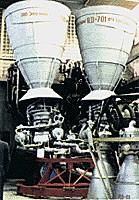
Home - Search - Browse - Alphabetic Index: 0- 1- 2- 3- 4- 5- 6- 7- 8- 9
A- B- C- D- E- F- G- H- I- J- K- L- M- N- O- P- Q- R- S- T- U- V- W- X- Y- Z
Lox/Kerosene/LH2
 RD-701 Credit: © Mark Wade |
Specific impulse: 440 s.
Optimum Oxidizer to Fuel Ratio: 4.8. Density: 0.50 g/cc. Fuel Density: 0.133 g/cc. Fuel Freezing Point: -259 deg C. Fuel Boiling Point: -253 deg C.
Figures indicated are average for RD-701 Tripropellant engine.
| MAKS Orbiter LOx/Kerosene/LH2 propellant rocket stage. Empty mass without 9300 kg payload. |
| MAKS Tank LOx/Kerosene/LH2 rocket stage. Mass 248,100 kg (546,967 lb). |
Engines: RD-0120TD, RD-0750, RD-701, RD-704. Stages: MAKS Tank, MAKS Orbiter.
Back to top of page
Home - Search - Browse - Alphabetic Index: 0- 1- 2- 3- 4- 5- 6- 7- 8- 9
A- B- C- D- E- F- G- H- I- J- K- L- M- N- O- P- Q- R- S- T- U- V- W- X- Y- Z
© 1997-2019 Mark Wade - Contact
© / Conditions for Use